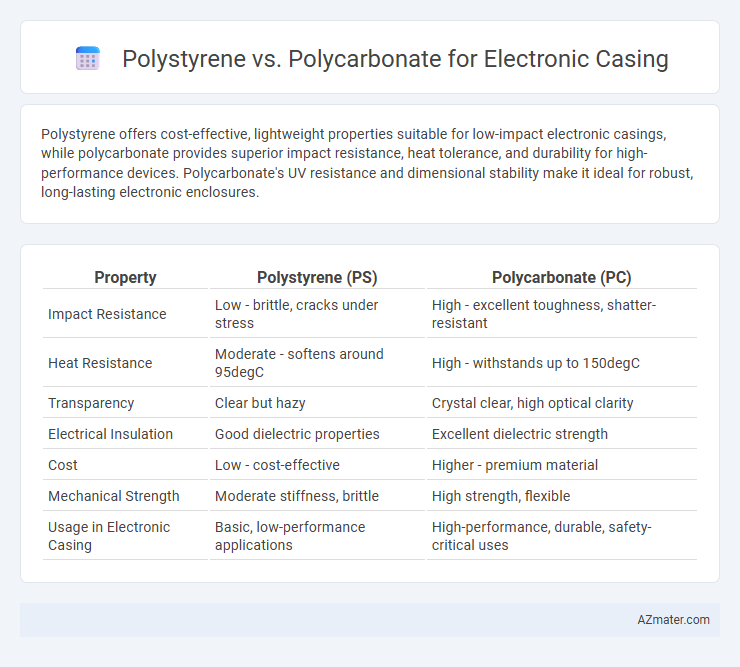Polystyrene offers cost-effective, lightweight properties suitable for low-impact electronic casings, while polycarbonate provides superior impact resistance, heat tolerance, and durability for high-performance devices. Polycarbonate's UV resistance and dimensional stability make it ideal for robust, long-lasting electronic enclosures.
Table of Comparison
| Property | Polystyrene (PS) | Polycarbonate (PC) |
|---|---|---|
| Impact Resistance | Low - brittle, cracks under stress | High - excellent toughness, shatter-resistant |
| Heat Resistance | Moderate - softens around 95degC | High - withstands up to 150degC |
| Transparency | Clear but hazy | Crystal clear, high optical clarity |
| Electrical Insulation | Good dielectric properties | Excellent dielectric strength |
| Cost | Low - cost-effective | Higher - premium material |
| Mechanical Strength | Moderate stiffness, brittle | High strength, flexible |
| Usage in Electronic Casing | Basic, low-performance applications | High-performance, durable, safety-critical uses |
Introduction to Electronic Casing Materials
Polystyrene and polycarbonate are key materials used in electronic casing, each offering distinct properties suited for device protection. Polystyrene provides excellent rigidity and cost-effectiveness, making it ideal for lightweight, low-impact applications. Polycarbonate stands out with superior impact resistance, heat tolerance, and transparency, often chosen for durable and high-performance electronic enclosures.
Overview of Polystyrene and Polycarbonate
Polystyrene is a lightweight, rigid thermoplastic known for its ease of molding and cost-effectiveness, commonly used in electronic casings requiring basic protection and insulation. Polycarbonate offers superior impact resistance, heat tolerance, and transparency, making it ideal for durable, high-performance electronic enclosures exposed to mechanical stress and elevated temperatures. Choosing between polystyrene and polycarbonate depends on balancing factors such as strength, thermal stability, and budget constraints for electronic casing applications.
Physical Properties Comparison
Polystyrene offers a low-density, rigid structure with moderate impact resistance and good dimensional stability, making it suitable for lightweight electronic casings. Polycarbonate exhibits superior impact strength, higher tensile strength, and excellent thermal resistance up to 150degC, providing robust protection against mechanical stress and heat. The choice depends on the required durability, with polycarbonate preferred for high-stress environments and polystyrene ideal for cost-effective, less demanding applications.
Mechanical Strength and Durability
Polycarbonate offers superior mechanical strength and impact resistance compared to polystyrene, making it ideal for electronic casings requiring high durability. Polystyrene is more brittle and prone to cracking under stress, limiting its use in applications exposed to frequent impact or heavy handling. The enhanced toughness and heat resistance of polycarbonate ensure longer-lasting protection for sensitive electronic components.
Thermal Resistance and Operating Temperature
Polycarbonate offers superior thermal resistance compared to polystyrene, withstanding continuous operating temperatures up to 130degC, while polystyrene typically tolerates only around 70-80degC. This higher thermal threshold makes polycarbonate ideal for electronic casings exposed to elevated heat or demanding conditions. Polystyrene's lower melting point and thermal stability limit its use in high-temperature electronic applications, where durability and heat resistance are critical.
Electrical Insulation Capabilities
Polystyrene offers good electrical insulation properties with a dielectric strength typically around 15-25 kV/mm, making it suitable for low-voltage electronic casings. Polycarbonate provides superior electrical insulation with higher dielectric strength often exceeding 20 kV/mm, coupled with excellent dimensional stability and impact resistance, which enhances protection for sensitive electronic components. The choice between polystyrene and polycarbonate depends on the voltage requirements and mechanical durability needed for the electronic casing application.
Chemical Resistance and Environmental Impact
Polycarbonate exhibits superior chemical resistance compared to polystyrene, making it more suitable for electronic casings exposed to solvents, oils, and cleaning agents. Polystyrene is prone to degradation and brittleness when faced with harsh chemicals, limiting its durability in demanding environments. Environmentally, polycarbonate offers better recyclability and a longer lifespan, reducing electronic waste, whereas polystyrene's limited recyclability and tendency to release harmful styrene monomers pose significant environmental concerns.
Cost and Manufacturing Considerations
Polystyrene offers a lower material cost and easier moldability, making it ideal for budget-sensitive electronic casing production with simple geometries. Polycarbonate, though more expensive, provides superior impact resistance and heat tolerance, justifying higher costs in applications requiring durability and safety. Manufacturing processes for polycarbonate often demand higher temperature molds and precision, increasing tooling expenses compared to the more straightforward injection molding of polystyrene.
Common Applications in Electronics
Polystyrene is commonly used for low-cost, lightweight electronic casings such as remote controls and disposable housings due to its ease of molding and surface finish. Polycarbonate is favored in applications requiring high impact resistance and thermal stability, making it ideal for durable smartphone cases, protective covers, and industrial electronic enclosures. Both materials offer distinct advantages depending on the mechanical and environmental demands of the electronic device.
Choosing the Right Material for Your Project
Polystyrene offers excellent cost-effectiveness and ease of molding for electronic casing but lacks the impact resistance and durability of polycarbonate. Polycarbonate provides superior toughness, high heat resistance, and enhanced electrical insulation, making it ideal for protecting sensitive components in demanding environments. Choosing between polystyrene and polycarbonate depends on balancing budget constraints with the need for durability, thermal stability, and safety in your specific electronic project.

Infographic: Polystyrene vs Polycarbonate for Electronic Casing
 azmater.com
azmater.com